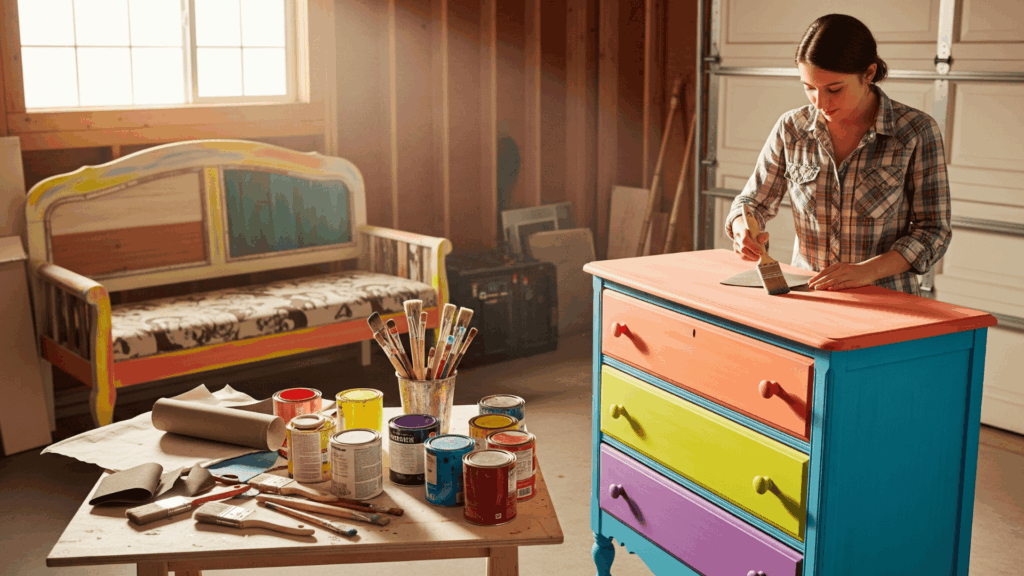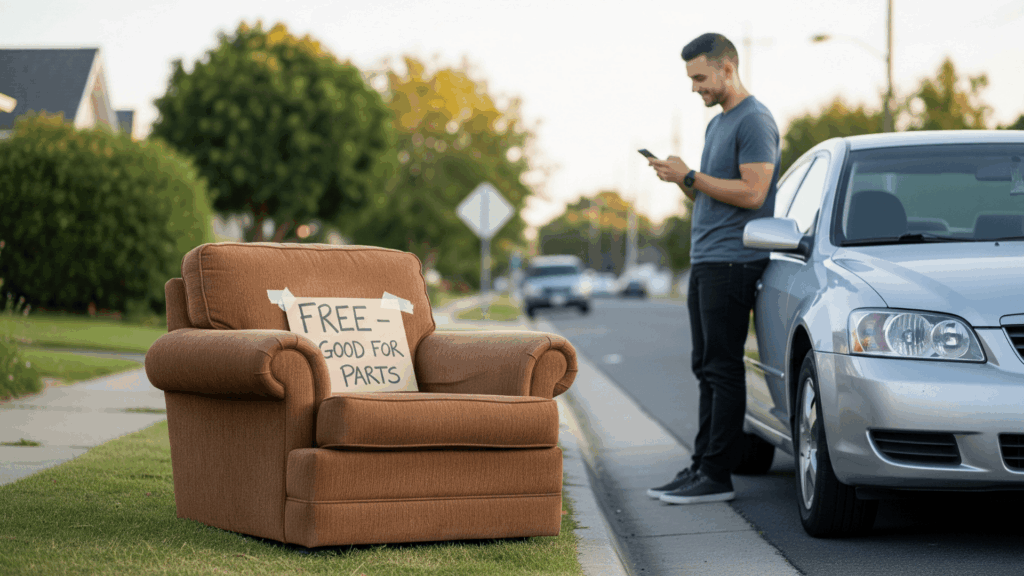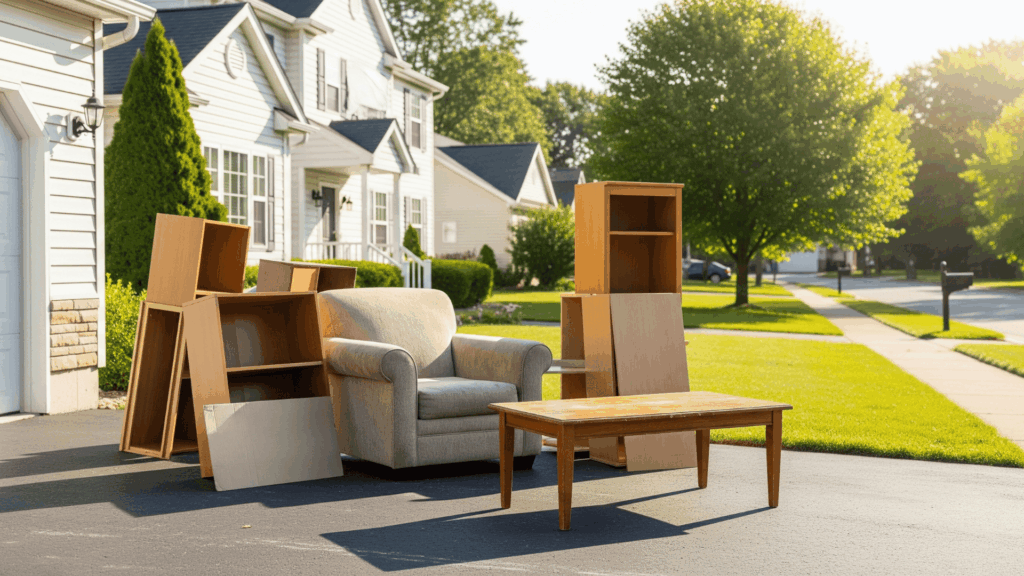I’ve stared at an old dresser, scuffed, bulky, and way too heavy to move. It sat in the corner for weeks because I had no clue what to do with it.
Selling didn’t work. Donating? The charity wouldn’t take it. Tossing it? My city had rules, and I didn’t have a truck.
If you’ve got an old couch, table, or bed frame gathering dust, you know the feeling.
Figuring out what to do with old furniture is harder than it should be. Oversized items, little help, and confusing options can make it feel like a full-time job.
In this blog, I’ll cover the most common struggles people face and share practical, real-world solutions.
You’ll find out how to get rid of old furniture, even the stuff nobody wants. Let’s make it simple, piece by piece.
How to Get Rid of Old Furniture Without Losing Your Mind
Getting rid of old furniture doesn’t have to be stressful. Start by deciding whether you want to donate, sell, or recycle the items.
For donations, consider contacting local charities or thrift stores that offer furniture pickup services.
If you prefer selling, try online marketplaces like Facebook Marketplace or Craigslist.
Recycling centers may accept broken furniture, or you can repurpose pieces for DIY projects.
If all else fails, hire a junk removal service to handle everything for you.
With a little planning, you can clear out your space and make room for something new without feeling overwhelmed.
Why Selling Old Furniture Isn’t Always Simple

Trying to sell old furniture sounds like the logical move until you actually try it. You take photos, write a post, and wait.
Then you realize your post is lost among hundreds of others or ignored altogether. Even if the furniture is in excellent condition, the selling process can quickly feel like more trouble than it’s worth.
1. Big Pieces Scare Off Buyers
Large furniture often remains unsold because most people lack trucks or strong helpers. Even if it’s free, the hassle of moving it turns buyers away fast.
Narrow stairways or small elevators exacerbate the issue, and many skip listings that seem too heavy or complicated. Unless it’s a high-value piece, buyers scroll past.
The size is more challenging than price or condition, making it difficult to sell bulky items.
2. Pricing Confusion
Setting the right price feels like a guessing game. Too high, and people move on. Too low, and they assume it’s broken or dirty. Some buyers only message to haggle, while others ghost you after asking questions.
A low price might grab attention, but it doesn’t guarantee a pickup. The middle range often leads to silence, leaving your listing stuck.
With so many secondhand items online, standing out is difficult, and making pricing mistakes is easy.
3. Safety Concerns
Selling furniture means meeting strangers, and not everyone is comfortable with that. Some buyers don’t show up, while others act pushy or awkward.
If you’re home alone or live in a remote area, it can feel unsafe. Even asking them to meet in public doesn’t help when it’s a sofa or a table.
Many skip selling entirely to avoid the chance of a bad experience. In the end, peace of mind often wins over making a few extra dollars.
The Hidden Hassles of Donating Old Furniture

- Check Donation Center Guidelines: Not all items are accepted, especially mattresses, large sofas, or pieces with visible damage like stains, tears, or odors.
- Confirm Pickup Fees: Some donation centers charge for pickup, often based on distance or item size.
- Plan Ahead: Pickup times can be long, and delays are common. If you’re in a hurry, consider other options.
- Call First: Always verify the donation center’s rules and availability before committing.
- Have a Backup Plan: If your furniture isn’t accepted or pickup is delayed, explore alternate donation or disposal options.
Why Moving Old Furniture Alone Can Be a Major Challenge

Moving old furniture seems simple until you face the reality that you can’t lift it, take it apart, or even fit it through the door. Without tools or a second pair of hands, you’re stuck.
Disassembling usually needs screwdrivers, pliers, or some strength to loosen heavy parts. Trying to force it through narrow doors or staircases can damage walls or floors.
Even if you get it outside, you still need to transport it. Renting a truck costs money and adds pressure, especially if you’re not used to driving larger vehicles.
All of this quickly turns a small task into something stressful and exhausting. These roadblocks are why many people give up halfway or let the furniture sit there for months.
Without proper help or equipment, moving bulky items becomes nearly impossible.
Is Hiring a Junk Removal Service Worth It?

Sometimes, paying a professional is just the easiest way out. If your furniture is too heavy, broken, or taking up space you need quickly, junk removal companies offer a no-hassle fix.
Still, if time or stress is a concern, this option might be worth the cost, especially for large cleanouts, short deadlines, or when all other options have failed.
1. Fast and Stress-Free
Junk removal services handle everything for you; just schedule and watch it disappear. You don’t need to lift, move, or coordinate anything.
It’s ideal if you’re short on time, but be prepared to pay based on how much space your stuff takes up or how long it takes to remove.
2. Great for Big Cleanouts
If you’re clearing out an entire room, garage, or downsizing quickly, junk removal can save hours.
You avoid multiple trips, long wait times, and the hassle of listing or donating each item. One phone call can clear a whole space in a single day.
3. Check for Recycling
Some companies sort and recycle materials like wood, metal, and fabric. This helps reduce landfill waste and makes your cleanout more eco-friendly.
Always ask if recycling or donation is part of their process before you book.
Can You Reuse or Repurpose Old Furniture?

Before you toss that beat-up table or old chair, think: could it be something new? You’d be surprised what a little paint, sanding, or creative thinking can do.
- Try a furniture flip: A simple coat of paint and fresh hardware can completely alter an old piece. That scratched-up dresser might become a bathroom vanity or a colorful hallway bench.
- Turn parts into DIY materials: Even if the whole item can’t be saved, its parts might be useful. Wood panels can become shelves, cushions can be turned into pet beds, and knobs can be reused on cabinets.
- Use online tutorials: If you’re new to flipping, check out YouTube or Pinterest for step-by-step guides. Many tutorials are beginner-friendly and use supplies you probably already have.
| Furniture Type | Repurpose Ideas | Potential Uses |
|---|---|---|
| Wooden Chairs | Turn into a shelf, garden planter, or art piece | Indoor decor, outdoor garden, storage |
| Old Dressers | Convert into a TV stand, kitchen island, or bathroom vanity | Living room, kitchen, or bathroom storage |
| Wooden Tables | Transform into a desk, workbench, or wall-mounted shelf | Home office, craft room, garage |
| Bookshelves | Use as a kitchen rack, shoe storage, or room divider | Kitchen, entryway, or as a functional divider |
| Mattresses | Repurpose fabric for pillows or use springs for art projects | DIY crafts, garden support |
| Couches/Chairs | Reupholster with fresh fabric or turn cushions into outdoor seating | Living room refresh, patio, or outdoor space |
| Cabinets | Use as a laundry room organizer or garage tool storage | Laundry, garage, or as a unique bookshelf |
Local and Unique Options to Get Rid of Old Furniture

Sometimes the best solutions are close to home. Instead of hauling furniture across town, you might be able to give it away within your neighborhood.
1. Post in Neighborhood Apps
Neighborhood apps like Nextdoor and local Facebook groups are perfect for giving away furniture fast.
Because the people seeing your post live nearby, you’re more likely to find someone who can pick it up quickly without needing help or delivery.
Just snap a photo, write a clear description, and post your general location. Most times, someone will respond the same day.
This method saves time, making it easy to pass things along without leaving your home or dealing with strangers far away.
2. College Move-ins
When college move-in season hits, students flood campuses looking for budget-friendly furniture. If you live near a school, posting desks, small couches, or chairs on student forums or apps can lead to fast pickups.
Most students don’t mind a few scratches and will gladly take usable furniture for free. Try timing your post around early August or January when semesters begin.
It’s a great way to give your items a second life while helping someone furnish their space on a tight budget.
3. Community Events
Local community events can be a great way to get rid of old furniture without stress. Look for citywide swap days, donation drives, or neighborhood garage sale weekends where people expect to give and take.
These events are often organized by libraries, town centers, or local websites. You can drop off your furniture or have someone pick it up with the help of event volunteers.
It’s easy, organized, and ideal if you want to clear space while supporting a shared community effort.
What to Do with Furniture Too Damaged to Sell or Donate

If your furniture is beyond fixing, there are still smart ways to get rid of it. You don’t need to leave it rotting in the basement.
- Curb Alerts: Post broken furniture online with a “Free, first come, first served” label. Someone might want it for parts or a DIY project.
- Break It Down: Disassemble the item to make it easier to handle and recycle properly. Some cities require bulky items to be broken down for pickup.
- Call Waste Services: Many cities offer bulk pickup days or free drop-offs. Call ahead to learn about available services and avoid extra fees.
Instead of dragging it to the dumpster or hiding it in the garage, try these final-resort ideas that still keep things responsible and sometimes even free.
The Bottom Line
I know how frustrating it is to have old furniture taking up space while every solution feels like a hassle. I’ve been there, too heavy to lift, too damaged to sell, and no idea who might want it.
But once I learned a few tricks, getting rid of furniture stopped feeling impossible.
Even if you donate, flip it, or just put it at the curb, there’s always a way. You don’t need to deal with it alone or let it sit there another month.
I hope this helped you figure out your next step.
If you know someone stuck with a bulky couch or old bed frame, share this blog with them. It might save them a headache or a backache.

